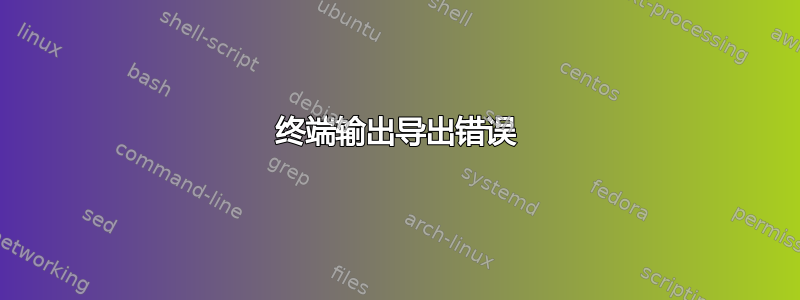
我正在运行一个python程序VGG16,它通过包使用神经网络keras对猫和狗的图像进行分类,卡格勒数据库。为此,我使用标准终端命令:python program.py > output.txt。我还尝试了其他变体,python program.py &> output.txt或tee命令python program.py |& tee output.txt,但似乎不起作用。对于第一个命令,我的文本文件仅包含:
Using TensorFlow backend.
2017-05-31 13:39:34.218034: W tensorflow/core/platform/cpu_feature_guard.cc:45]
The TensorFlow library wasn't compiled to use SSE4.1 instructions, but these are
available on your machine and could speed up CPU computations.
2017-05-31 13:39:34.226941: W tensorflow/core/platform/cpu_feature_guard.cc:45]
The TensorFlow library wasn't compiled to use SSE4.2 instructions, but these are
available on your machine and could speed up CPU computations.
但代码中有很多print语句!文件的预期内容output.txt是(仅显示终端输出的前 4-5 行):
Using TensorFlow backend.
Defining all the path!
All paths defined!
Getting mean RGB and creating labels!
当我输入时就会显示出来python program.py。部分内容:
2017-05-31 13:39:34.218034: W tensorflow/core/platform/cpu_feature_guard.cc:45]
The TensorFlow library wasn't compiled to use SSE4.1 instructions, but these are
available on your machine and could speed up CPU computations.
2017-05-31 13:39:34.226941: W tensorflow/core/platform/cpu_feature_guard.cc:45]
The TensorFlow library wasn't compiled to use SSE4.2 instructions, but these are
available on your machine and could speed up CPU computations.
这部分在终端输出中出现得更晚。我把我的代码放在这里供参考,但它有 204 行长:
import keras
from keras.models import Sequential, Model
from keras.layers import Flatten, Dense, Dropout, Input, Activation
from keras.layers.convolutional import Conv2D, MaxPooling2D, ZeroPadding2D
from keras.layers.merge import Add
from keras.optimizers import SGD, Adam
import cv2, numpy as np
import glob
import csv
####################
## VGG16 Function ##
####################
def VGG_16(weights_path=None, classes=2):
######################################
## Input: 3x224x224 sized RGB Input ##
######################################
inputs = Input(shape=(3,224,224))
layer = 0
#############
## Block 1 ##
#############
x = Conv2D(64, (3, 3), data_format='channels_first', activation='relu', padding='same', name='block1_conv1')(inputs)
layer += 1
print ('Output shape for Layer ' +str(layer)+ ', is, ' +str(x.get_shape()))
x = Conv2D(64, (3, 3), data_format='channels_first', activation='relu', padding='same', name='block1_conv2')(x)
layer += 1
print ('Output shape for Layer ' +str(layer)+ ', is, ' +str(x.get_shape()))
x = MaxPooling2D((2, 2), strides=(2, 2), name='block1_pool')(x)
#############
## Block 2 ##
#############
x = Conv2D(128, (3, 3), data_format='channels_first', activation='relu', padding='same', name='block2_conv1')(x)
layer += 1
print ('Output shape for Layer ' +str(layer)+ ', is, ' +str(x.get_shape()))
x = Conv2D(128, (3, 3), data_format='channels_first', activation='relu', padding='same', name='block2_conv2')(x)
layer += 1
print ('Output shape for Layer ' +str(layer)+ ', is, ' +str(x.get_shape()))
x = MaxPooling2D((2, 2), strides=(2, 2), name='block2_pool')(x)
#############
## Block 3 ##
#############
x = Conv2D(256, (3, 3), data_format='channels_first', activation='relu', padding='same', name='block3_conv1')(x)
layer += 1
print ('Output shape for Layer ' +str(layer)+ ', is, ' +str(x.get_shape()))
x = Conv2D(256, (3, 3), data_format='channels_first', activation='relu', padding='same', name='block3_conv2')(x)
layer += 1
print ('Output shape for Layer ' +str(layer)+ ', is, ' +str(x.get_shape()))
x = Conv2D(256, (3, 3), data_format='channels_first', activation='relu', padding='same', name='block3_conv3')(x)
layer += 1
print ('Output shape for Layer ' +str(layer)+ ', is, ' +str(x.get_shape()))
x = MaxPooling2D((2, 2), strides=(2, 2), name='block3_pool')(x)
#############
## Block 4 ##
#############
x = Conv2D(512, (3, 3), data_format='channels_first', activation='relu', padding='same', name='block4_conv1')(x)
layer += 1
print ('Output shape for Layer ' +str(layer)+ ', is, ' +str(x.get_shape()))
x = Conv2D(512, (3, 3), data_format='channels_first', activation='relu', padding='same', name='block4_conv2')(x)
layer += 1
print ('Output shape for Layer ' +str(layer)+ ', is, ' +str(x.get_shape()))
x = Conv2D(512, (3, 3), data_format='channels_first', activation='relu', padding='same', name='block4_conv3')(x)
layer += 1
print ('Output shape for Layer ' +str(layer)+ ', is, ' +str(x.get_shape()))
x = MaxPooling2D((2, 2), strides=(2, 2), name='block4_pool')(x)
#############
## Block 5 ##
#############
x = Conv2D(512, (3, 3), data_format='channels_first', activation='relu', padding='same', name='block5_conv1')(x)
layer += 1
print ('Output shape for Layer ' +str(layer)+ ', is, ' +str(x.get_shape()))
x = Conv2D(512, (3, 3), data_format='channels_first', activation='relu', padding='same', name='block5_conv2')(x)
layer += 1
print ('Output shape for Layer ' +str(layer)+ ', is, ' +str(x.get_shape()))
x = Conv2D(512, (3, 3), data_format='channels_first', activation='relu', padding='same', name='block5_conv3')(x)
layer += 1
print ('Output shape for Layer ' +str(layer)+ ', is, ' +str(x.get_shape()))
out = MaxPooling2D((2, 2), strides=(2, 2), name='block5_pool')(x)
###############
## Top layer ##
###############
out = Flatten(name='flatten')(out)
out = Dense(4096, activation='relu', name='fc1')(out)
out = Dropout(0.5)(out)
out = Dense(4096, activation='relu', name='fc2')(out)
out = Dropout(0.5)(out)
out = Dense(classes, activation='softmax', name='predictions')(out)
if weights_path:
model.load_weights(weights_path)
model = Model(inputs, out, name='vgg-16')
return model
###################
## Main Function ##
###################
if __name__ == "__main__":
################################################
## Get all the training and the testing paths ##
################################################
print('Defining all the path!\n')
cat_path = "./train/cat.*.jpg"
dog_path = "./train/dog.*.jpg"
train_path = "./train/*.jpg"
test_path = "./test1/*.jpg"
Mean_RGB = []
x_train = []
y_train = []
x_test = []
print('All paths defined!\n')
########################################################################
## Get training and testng data sizes, to find the average RGB values ##
########################################################################
print('Getting mean RGB and creating labels!\n')
for file in glob.glob(cat_path): # To get the sizes of all the cat images
im = cv2.resize(cv2.imread(file), (224, 224)).astype(np.float32)
im = np.mean(im, axis=(0,1))
Mean_RGB.append(tuple(im))
y_train.append(0)
for file in glob.glob(dog_path): # To get the sizes of all the dog images
im = cv2.resize(cv2.imread(file), (224, 224)).astype(np.float32)
im = np.mean(im, axis=(0,1))
Mean_RGB.append(tuple(im))
y_train.append(1)
y_train = np.array(y_train)
Mean_RGB = tuple(np.mean(Mean_RGB, axis=0))
print('Got mean RGB and created labels!\n')
#########################################################################
## Load the training and testing images, after subtracting average RGB ##
#########################################################################
print('Loading images as numpy arrays!\n')
for file in glob.glob(train_path):
im = cv2.resize(cv2.imread(file), (224, 224)).astype(np.float32)
im_r = im-Mean_RGB
im_r = im_r.transpose((2,0,1))
#im_r = np.expand_dims(im_r, axis=0)
x_train.append(im_r)
y_train = y_train.reshape((-1,1))
y_train = keras.utils.to_categorical(y_train, num_classes=2)
x_train = np.array(x_train)
for file in glob.glob(test_path):
im = cv2.resize(cv2.imread(file), (224, 224)).astype(np.float32)
im_r = im-Mean_RGB
im_r = im_r.transpose((2,0,1))
#im_r = np.expand_dims(im_r, axis=0)
x_test.append(im_r)
x_test = np.array(x_test)
print('All images loaded!\n')
##############################
## Train and test the model ##
##############################
print('Creating Neural Net!\n')
model = VGG_16()
print('\nNeural Net created!\n')
adam = Adam(lr=0.001, beta_1=0.9, beta_2=0.999, epsilon=1e-08, decay=0.0)
model.compile(optimizer=adam, loss='binary_crossentropy', metrics=['accuracy'])
print('Training Neural Net!\n')
### Generating validation data split in training sample
model.fit(x_train, y_train, batch_size=500, epochs=25, validation_split=0.2, shuffle=True)
print('Neural Net trained!\n')
print('Evaluating model on the training images!\n')
score = model.evaluate(x_train, y_train, batch_size=500, verbose=1)
print('Model score on training data: ' +str(score)+ '\n')
print('Predicting class of test images!\n')
pred = model.predict(x_test, batch_size=1, verbose=1)
prediction = np.argmax(pred, axis = 1)
print('Predictions done!\n')
result = []
print('Creating output CSV file!\n')
result.append(['id', 'label'])
for i in range(0,len(prediction)):
result.append([i+1,prediction[i]])
with open("cat-dog-output.csv","wb") as f:
writer = csv.writer(f)
writer.writerows(result)
print('Created output CSV file!\n')
print('Saving model parameters!\n')
model.save('vgg16-sim-conn.h5')
model.save_weights('vgg16-sim-conn-weights.h5')
print('Model saved!\n')
我不知道到底发生了什么,如能提供任何帮助我将不胜感激!
答案1
这与您的问题有关吗?https://stackoverflow.com/q/27534609尝试-u在启动 Python 时添加标志


